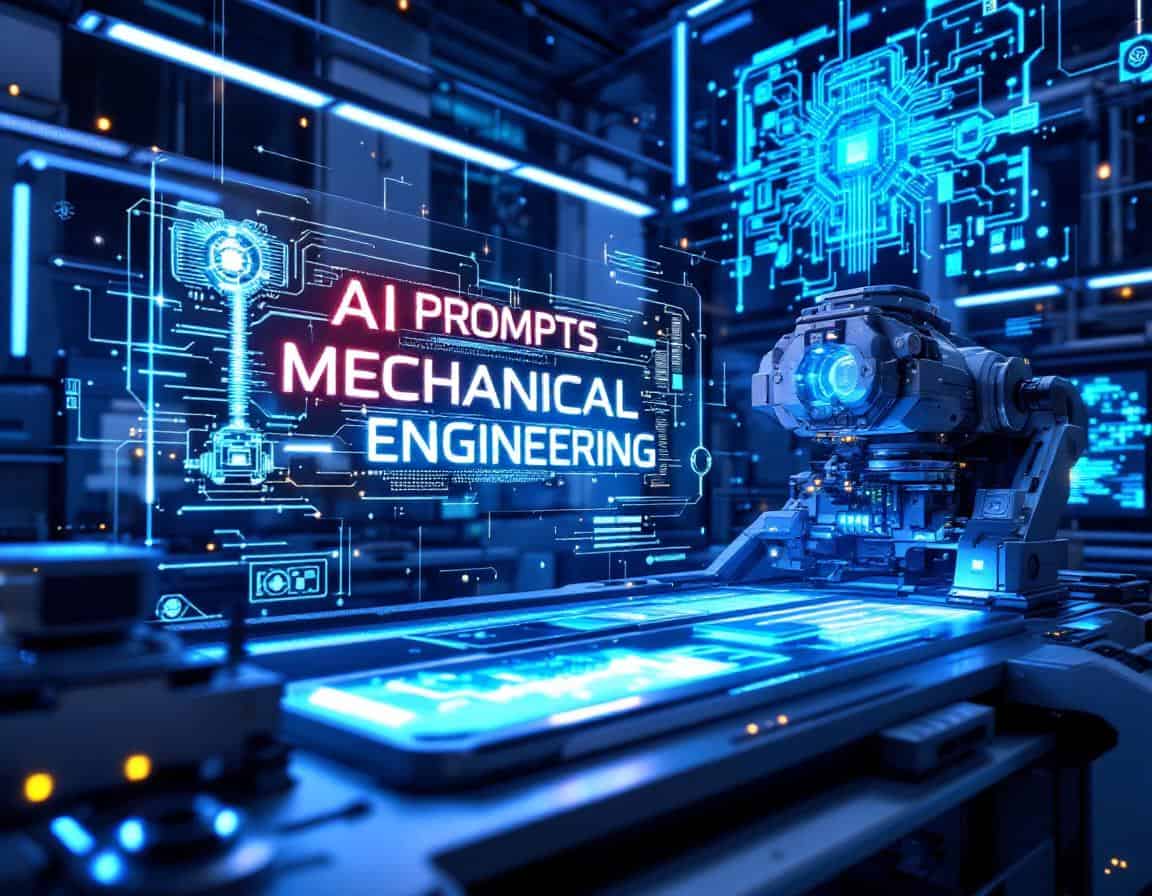
تعمل أدوات الذكاء الاصطناعي عبر الإنترنت على إحداث تحول سريع في الهندسة الميكانيكية من خلال زيادة القدرات البشرية في التصميم والتحليل, التصنيعوالصيانة. يمكن لأنظمة الذكاء الاصطناعي هذه معالجة كميات هائلة من البيانات، وتحديد الأنماط المعقدة، وتوليد حلول جديدة أسرع بكثير من الطرق التقليدية. على سبيل المثال، يمكن أن يساعدك الذكاء الاصطناعي في تحسين التصاميم من حيث الأداء وقابلية التصنيع، وتسريع عمليات المحاكاة المعقدة، والتنبؤ بخصائص المواد، وأتمتة مجموعة واسعة من المهام التحليلية.
The prompts provided below will for example help on generative design, accelerate simulations (FEA/CFD), help on predictive maintenance where AI analyzes sensor data from machinery to forecast potential failures, enabling proactive servicing and minimizing downtime, help on material selection and much more.
- هذه الصفحة خاصة بنطاق واحد. إذا لزم الأمر، يمكنك الحصول على إمكانيات بحث كاملة حسب جميع المجالات وجميع المعايير في > دليل موجهات الذكاء الاصطناعي <، مخصص لـ تصميم المنتج و ابتكار.
- نظرًا لموارد الخادم والوقت، فإن المطالبات نفسها محجوزة للأعضاء المسجلين فقط، ولا تظهر أدناه إذا لم تكن مسجلاً. يمكنك التسجيل، 100% مجاناً:
- تحليل السبب الجذري
- الهندسة الميكانيكية
موجه الذكاء الاصطناعي إلى Comparative RCA for Repetitive Failures
- التحسين المستمر, الإجراء التصحيحي, التصميم من أجل التصنيع (DfM), تحليل الفشل, التصنيع اللين, الهندسة الميكانيكية, تحسين العمليات, إدارة الجودة, تحليل السبب الجذري
Analyzes textual descriptions from multiple incident reports of a repetitive failure in a mechanical system. This prompt aims to identify common patterns potential shared root causes and any differentiating factors across incidents helping to solve persistent issues. The output is a markdown formatted comparative analysis.
المخرجات:
- تخفيض السعر
- لا يتطلب إنترنت مباشر
- Fields: {system_or_component_name} {common_failure_description} {multiple_failure_incident_reports_text}
- Best for: Assisting mechanical engineers in diagnosing recurrent system failures by comparatively analyzing multiple incident reports to identify common patterns and potential shared root causes.
- تحسين التصميم التجريبي
- الهندسة الميكانيكية
موجه الذكاء الاصطناعي إلى منشئ قائمة مراجعة التحقق من صحة البيانات التجريبية
- الهندسة الميكانيكية, ضمان الجودة, مراقبة الجودة, إدارة الجودة, التحليل الإحصائي, طرق الاختبار, تصديق, التحقق
تطلب هذه المطالبة من الذكاء الاصطناعي إنشاء قائمة مراجعة مفصلة للتحقق من جودة وسلامة البيانات التجريبية للهندسة الميكانيكية التجريبية بناءً على وصف التجربة ونوع البيانات التي قدمها المستخدم.
المخرجات:
- تخفيض السعر
- لا يتطلب إنترنت مباشر
- الحقول: {وصف_التجربة} {نوع_البيانات}
- الأفضل لـ الأفضل لضمان جمع البيانات التجريبية عالية الجودة والموثوقة وتحليلها
- مقترح المنحة والمساعدة في الكتابة العلمية
- الهندسة الميكانيكية
موجه الذكاء الاصطناعي إلى هيكل مراجعة الأدبيات للمقدمة
- التصنيع المضاف, التحسين المستمر, التصميم من أجل التصنيع الإضافي (DfAM), ابتكار, الهندسة الميكانيكية, إدارة الجودة, ممارسات الاستدامة
يساعد في هيكلة مراجعة الأدبيات لقسم مقدمة الورقة البحثية من خلال تحديد الموضوعات الرئيسية من الملخصات المقدمة واقتراح تدفق منطقي لتحديد الفجوة البحثية لموضوع الهندسة الميكانيكية. المخرجات عبارة عن مخطط تفصيلي وإرشادات سردية.
المخرجات:
- تخفيض السعر
- لا يتطلب إنترنت مباشر
- الحقول: {عنوان_موضوع_البحث} {قائمة_بالملخصات_المفاتيح_المفاتيح_أو_نص_الصحف} {البحث_الرئيسي_الفجوة_الرئيسية_أو_السؤال}
- الأفضل لـ مساعدة المهندسين الميكانيكيين على هيكلة مراجعة الأدبيات في مقدمات الأوراق البحثية من خلال تنظيم المعلومات من الملخصات الموجودة بشكل موضوعي ومنطقي يؤدي إلى فجوة البحث.
- النمذجة التنبؤية
- الهندسة الميكانيكية
موجه الذكاء الاصطناعي إلى منشئ نموذج التنبؤ بخصائص المواد
- التعلّم الآلي, المواد, الهندسة الميكانيكية, الخواص الميكانيكية, خوارزميات الصيانة التنبؤية, مراقبة الجودة, إدارة الجودة, التحليل الإحصائي
يرشد هذا الموجه الذكاء الاصطناعي إلى بناء نموذج تنبؤي لخصائص المواد الميكانيكية استنادًا إلى بيانات الاختبار التاريخية التي يقدمها المستخدم بتنسيق CSV. وهو يتضمن خطوات اختيار النموذج والتدريب والتحقق من صحة النموذج.
المخرجات:
- بايثون
- لا يتطلب إنترنت مباشر
- الحقول: {csv_material_data} {الخاصية_المستهدفة}
- الأفضل لـ الأفضل لإنشاء نماذج تعتمد على البيانات للتنبؤ بسلوك المواد
- النمذجة التنبؤية
- الهندسة الميكانيكية
موجه الذكاء الاصطناعي إلى أداة التنبؤ بأداء النظام
- تقييم الأثر البيئي, التقنيات البيئية, التعلّم الآلي, خوارزميات الصيانة التنبؤية, إدارة الجودة, التحليل الإحصائي, التحكم في العمليات الإحصائية (SPC), تصميم النظام
تطلب هذه المطالبة من الذكاء الاصطناعي التنبؤ بالأداء المستقبلي لنظام ميكانيكي بناءً على البيانات التشغيلية التاريخية والعوامل البيئية المقدمة بتنسيق JSON. يقوم الذكاء الاصطناعي بإخراج تنبؤ سلسلة زمنية مع فترات ثقة.
المخرجات:
- JSON
- لا يتطلب إنترنت مباشر
- الحقول: {historical_data_data_json} {العوامل_البيئية_json}
- الأفضل لـ الأفضل لتوقع سلوك النظام الميكانيكي في ظل ظروف مختلفة
- النمذجة التنبؤية
- الهندسة الميكانيكية
موجه الذكاء الاصطناعي إلى نموذج تقدير احتمالية الفشل
- تحليل الفشل, تحليل نمط الفشل والآثار (FMEA), الصيانة, الهندسة الميكانيكية, خوارزميات الصيانة التنبؤية, تحليل المخاطر, إدارة المخاطر, التحليل الإحصائي
توجه هذه المطالبة الذكاء الاصطناعي إلى تطوير نموذج تنبؤي لتقدير احتمالية فشل المكونات الميكانيكية بناءً على ميزات الإدخال وبيانات الفشل التاريخية المقدمة بتنسيق CSV. يتضمن شرح النموذج وتعليمات الاستخدام.
المخرجات:
- بايثون
- لا يتطلب إنترنت مباشر
- الحقول: {csv_failure_data} {ميزات_المكون}
- الأفضل ل: الأفضل للتنبؤ بموثوقية المكونات وجدولة الصيانة
- النمذجة التنبؤية
- الهندسة الميكانيكية
موجه الذكاء الاصطناعي إلى التنبؤ بالاستجابة الميكانيكية الحيوية للمواد
- المواد الحيوية, التصميم من أجل التصنيع الإضافي (DfAM), طريقة العناصر المحدودة (FEM), علم المواد, الهندسة الميكانيكية, الخواص الميكانيكية, خوارزميات الصيانة التنبؤية, الهندسة الإنشائية
تطلب هذه المطالبة من الذكاء الاصطناعي التنبؤ بالاستجابات الميكانيكية الحيوية للمواد تحت ظروف تحميل محددة. يقوم المستخدم بإدخال خصائص المواد وبارامترات التحميل، ويقوم الذكاء الاصطناعي بإنتاج نموذج استجابة مفصل.
المخرجات:
- LaTeX
- لا يتطلب إنترنت مباشر
- الحقول: {خصائص_المواد} {شروط_التحميل}
- الأفضل لـ الأفضل لنمذجة السلوك الميكانيكي للمواد تحت الأحمال الميكانيكية الحيوية
- تحليل السبب الجذري
- الهندسة الميكانيكية
موجه الذكاء الاصطناعي إلى مولد فرضية السبب الجذري للفشل
- التحسين المستمر, تحليل الفشل, تحليل نمط الفشل والآثار (FMEA), التصنيع اللين, تقنيات حل المشكلات, تحسين العمليات, إدارة الجودة, تحليل السبب الجذري, سداسية سيجما
توجّه هذه المطالبة الذكاء الاصطناعي لتوليد فرضيات السبب الجذري المعقول لحدث عطل ميكانيكي بناءً على وصف تفصيلي للفشل والأعراض الملاحظة التي يقدمها المستخدم.
المخرجات:
- النص
- لا يتطلب إنترنت مباشر
- الحقول: {الوصف_الفشل} {الأعراض_الملحوظة}
- الأفضل لـ: الأفضل للتحقيق الأولي وتضييق نطاق أسباب الفشل
- تحليل السبب الجذري
- الهندسة الميكانيكية
موجه الذكاء الاصطناعي إلى منشئ تحليل شجرة الأعطال
- تحليل الفشل, تحليل نمط الفشل والآثار (FMEA), تحليل شجرة الأعطال (FTA), الهندسة الميكانيكية, تحسين العمليات, مراقبة الجودة, إدارة الجودة, تحليل المخاطر, إدارة المخاطر
تطلب هذه المطالبة من الذكاء الاصطناعي إنشاء مخطط تحليل شجرة أعطال بتنسيق نصي لحدث فشل نظام ميكانيكي معين. يقدم المستخدم وصف حدث العطل والمكونات المعنية.
المخرجات:
- تخفيض السعر
- لا يتطلب إنترنت مباشر
- الحقول: {حدث_الفشل} {مكونات_النظام}
- الأفضل ل: الأفضل لتصور انتشار الفشل والتبعيات في الأنظمة الميكانيكية
- تحليل السبب الجذري
- الهندسة الميكانيكية
موجه الذكاء الاصطناعي إلى مصفوفة تحديد أولويات نمط الفشل
- التحسين المستمر, الإجراء التصحيحي, تحليل الفشل, تحليل نمط الفشل والآثار (FMEA), تحسين العمليات, مراقبة الجودة, إدارة الجودة, تحليل المخاطر, إدارة المخاطر
تطلب هذه المطالبة من الذكاء الاصطناعي إنشاء مصفوفة تحديد أولويات وضع الفشل استنادًا إلى مدخلات ملف CSV لأنماط الفشل وخطورتها وحدوثها وتقييمات الكشف. يساعد في تحديد أولويات الأسباب الجذرية للأعطال الميكانيكية.
المخرجات:
- CSV
- لا يتطلب إنترنت مباشر
- الحقول: {csv_failure_modes}
- الأفضل لـ الأفضل لتحديد أولويات تحقيقات الفشل والإجراءات التصحيحية من الناحية الكمية



























هل نفترض أن الذكاء الاصطناعي قادر دائمًا على توليد أفضل المطالبات في الهندسة الميكانيكية؟ كيف يتم توليدها بالمناسبة؟
هل سيجعل الذكاء الاصطناعي المهندسين البشريين زائدين عن الحاجة؟
منشورات ذات صلة
التضليل البيئي: أفضل 15 نصيحة من رجل نبيل للخداع المتقن
كيفية التعامل مع براءة اختراع معلقة بأفضل طريقة
جميع حالات براءات الاختراع: معاهدة التعاون بشأن البراءات مقابل براءة اختراع قيد الانتظار مقابل براءة اختراع منشورة مقابل براءة اختراع ممنوحة
أفضل 10 استراتيجيات وأدوات لإبطال براءات الاختراع
تقييم دورة الحياة (LCA) في تصميم المنتج على وجه التحديد
نظرة عامة على تحليل قيمة المنتج